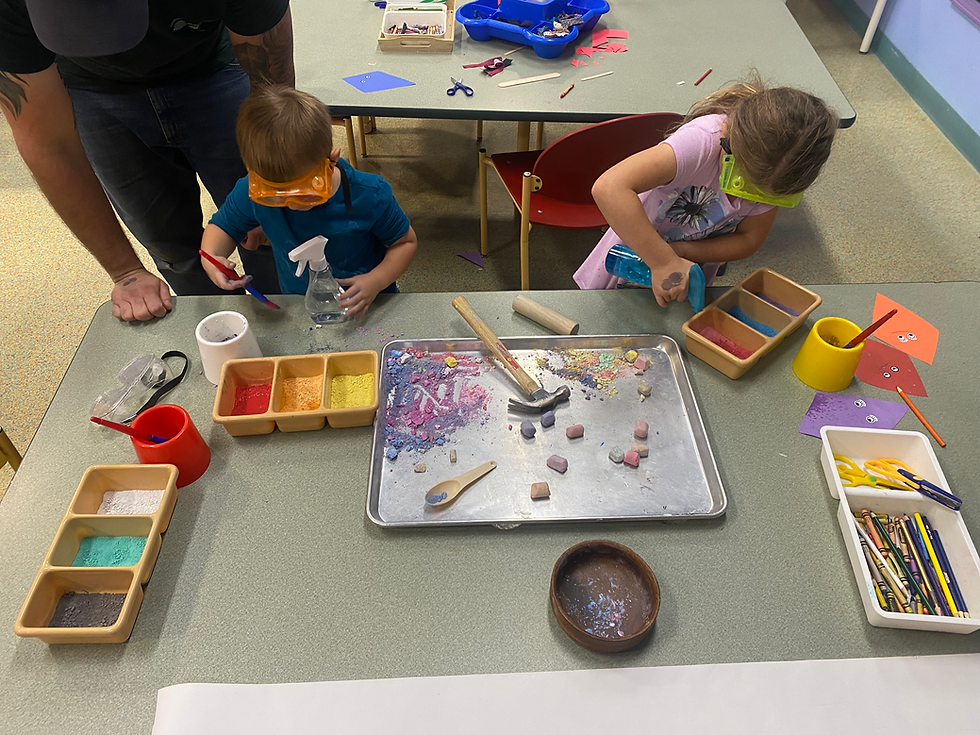Behind the Exhibits: How Play Becomes Learning
- adamwoodworth7
- May 19
- 3 min read

At the Children's Museum in Oak Lawn, we believe that play is more than just fun—it's a powerful tool for learning. Our exhibits are thoughtfully designed to engage children in hands-on experiences that foster curiosity, creativity, and critical thinking. By aligning with industry standards and best practices, we ensure that each play experience contributes meaningfully to a child's development.
🎨Designing Exhibits with Purpose
Each exhibit at our museum is crafted with intentionality, focusing on key developmental domains such as cognitive, social-emotional, and physical growth. For instance, our "Friendly Market" encourages role-play and social interaction, helping children develop communication skills and understand community roles. Similarly, the "Build It Workshop" promotes problem-solving and fine motor skills as children construct and create with various materials.
🧠 The Science Behind Play
Research supports the idea that play is a critical component of early childhood education. According to the Association of Children's Museums, play-based learning allows children to explore concepts at their own pace, fostering deeper understanding and retention. Our exhibits are designed to align with this philosophy, providing open-ended experiences that encourage exploration and discovery.
🌱 Growing Through Repetition
At the Children’s Museum in Oak Lawn, we understand that meaningful learning doesn’t happen in a single moment—it’s built through repetition, reflection, and a growing sense of mastery over time. Children often return to the same exhibit or activity over and over, and while adults may see this as “doing the same thing,” it’s actually a key part of the learning process.
Each repetition allows a child to experiment with new strategies, build on prior knowledge, and grow in confidence. For example, a child visiting our "Build It Workshop" may start by simply stacking blocks, but over multiple visits, they may begin to design elaborate structures, solve stability challenges, or collaborate with peers—all signs of deeper cognitive and social engagement.
That said, repetition works best when paired with breadth—a wide array of experiences that stimulate different developmental domains. That's why we offer a diverse range of exhibits: from pretend play in the "Friendly Market" and "Vet Clinic," to physical exploration in the "Tuneful Tree House," to creative expression in our "Art Studio." These varied experiences introduce children to new ideas, materials, and types of problem-solving.
What’s the balance? We design the museum environment to encourage focused revisits as well as broad exploration. Our term for this at the Children's Museum in Oak Lawn is "layering" exhibits with the idea that children will discover new ways to play on future visits. Children can return to a favorite exhibit to refine a skill or understanding, while also being invited to try something new that stretches their thinking in a different direction. This intentional balance supports the whole child—nurturing both depth of knowledge and a flexible, curious mind.
So when your child runs back to that same cash register, train table, or pet in the vet area for the tenth time, take a moment to notice how they’re doing it differently—and celebrate the learning that’s unfolding right in front of you.

🤝 Partnering with Families
We encourage parents and caregivers to participate in their children's play experiences. By observing and engaging with your child, you can gain insights into their interests and developmental progress. Our staff is always available to provide guidance and suggest ways to extend learning beyond the museum visit.
At the Children's Museum in Oak Lawn, we're committed to creating a nurturing environment where play and learning go hand in hand. We invite you to explore our exhibits and discover the joy of learning through play.
Visit us at cmoaklawn.org to plan your next visit and learn more about our programs and exhibits.
References
Association of Children’s Museums. (2022). Standards for Professional Practice in Children’s Museums. Retrieved from https://childrensmuseums.org
Ginsburg, K. R., & the Committee on Communications and the Committee on Psychosocial Aspects of Child and Family Health. (2007). The Importance of Play in Promoting Healthy Child Development and Maintaining Strong Parent–Child Bonds. Pediatrics, 119(1), 182-191. doi:10.1542/peds.2006-2697
Hirsh-Pasek, K., & Golinkoff, R. M. (2008). Why Play = Learning: A Challenge for Parents and Educators. In E. F. Zigler, D. G. Singer, & S. J. Bishop-Josef (Eds.), Play = Learning: How Play Motivates and Enhances Children's Cognitive and Social-Emotional Growth (pp. 3-12). Oxford University Press.
National Association for the Education of Young Children (NAEYC). (2020). Developmentally Appropriate Practice in Early Childhood Programs Serving Children from Birth Through Age 8, 4th ed. Washington, DC: NAEYC.
Whitebread, D. (2012). The Importance of Play: A Report on the Value of Children's Play with a Series of Policy Recommendations. University of Cambridge. Retrieved from https://www.importanceofplay.eu
.png)

